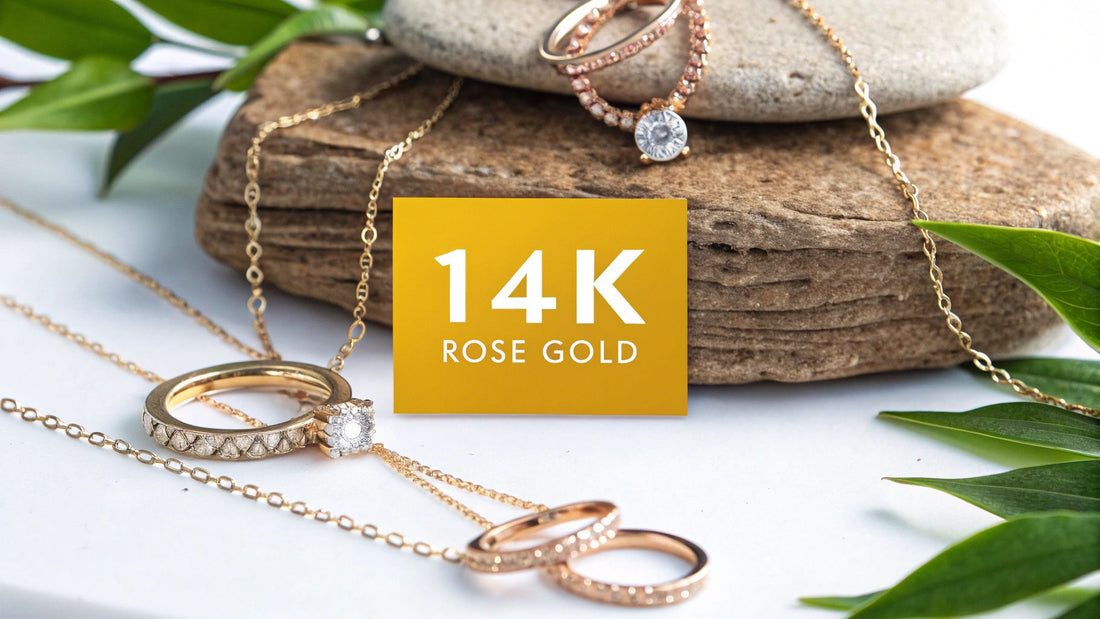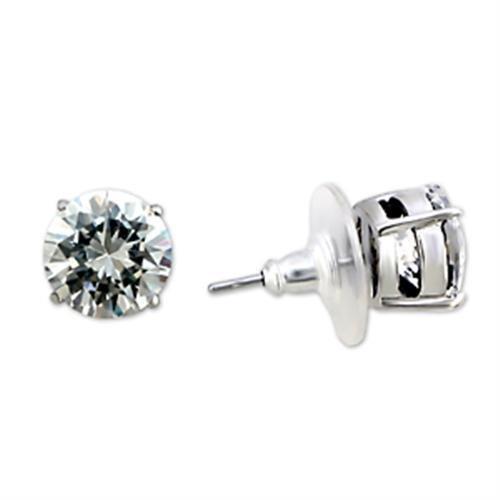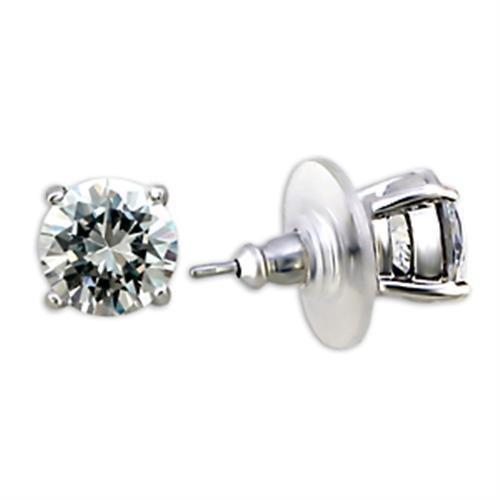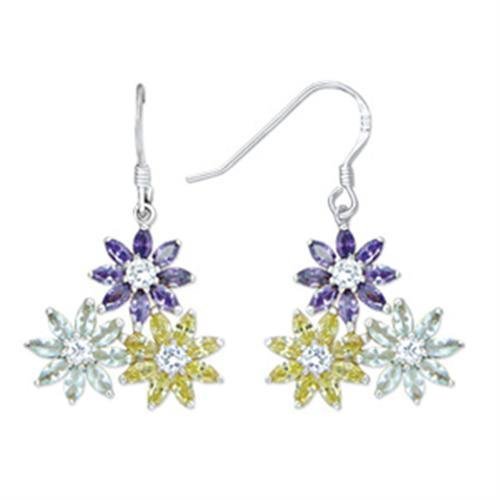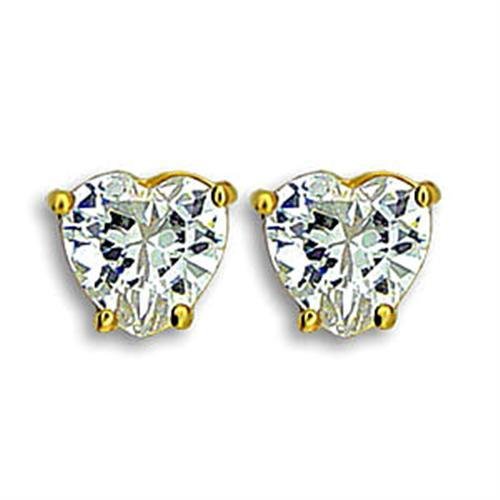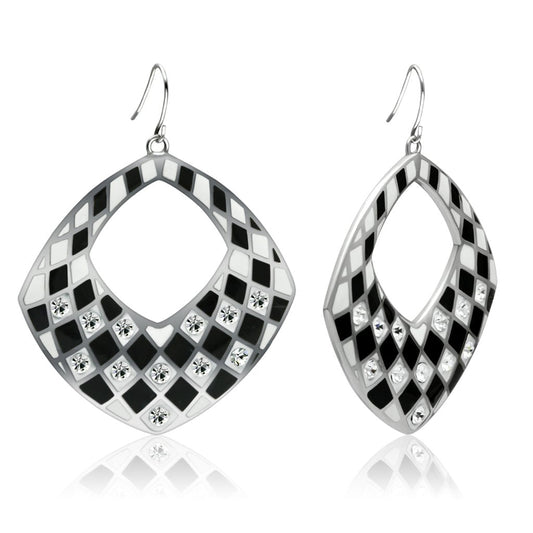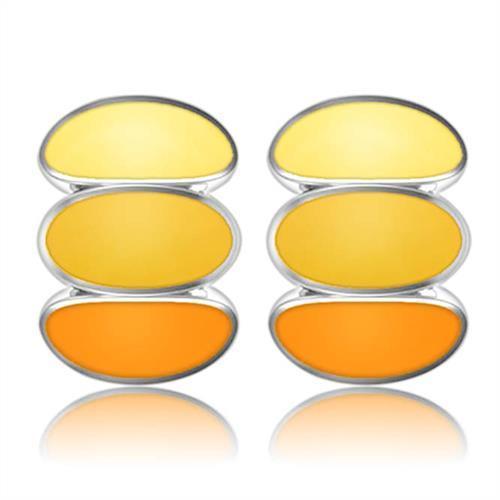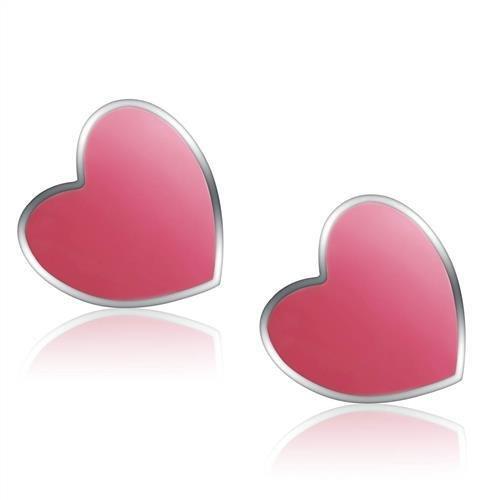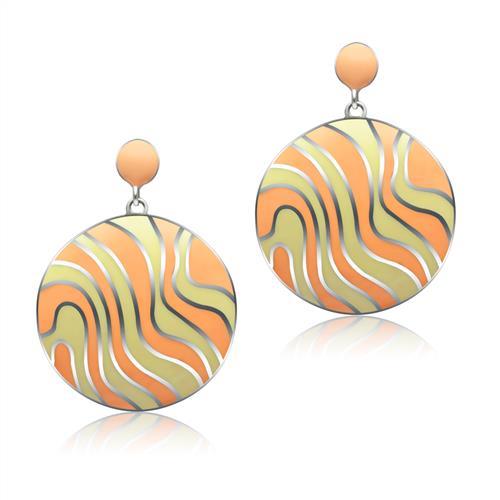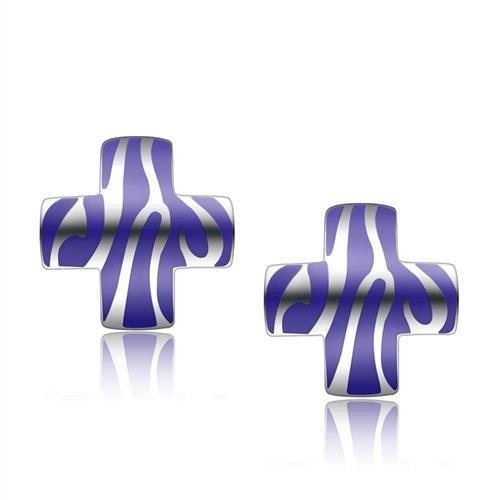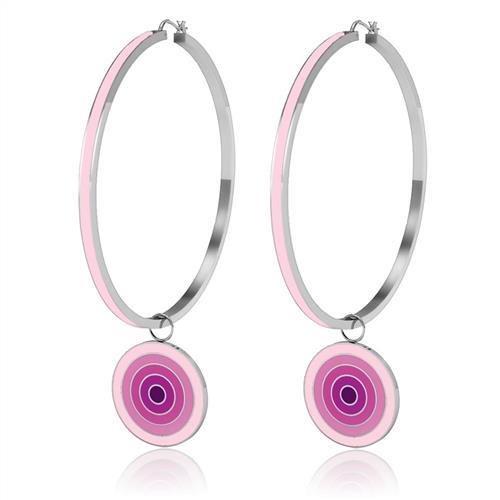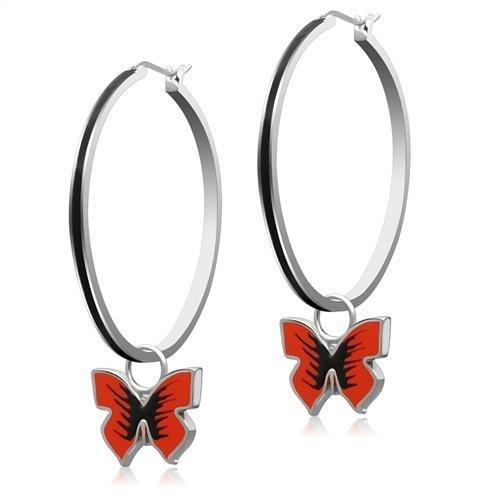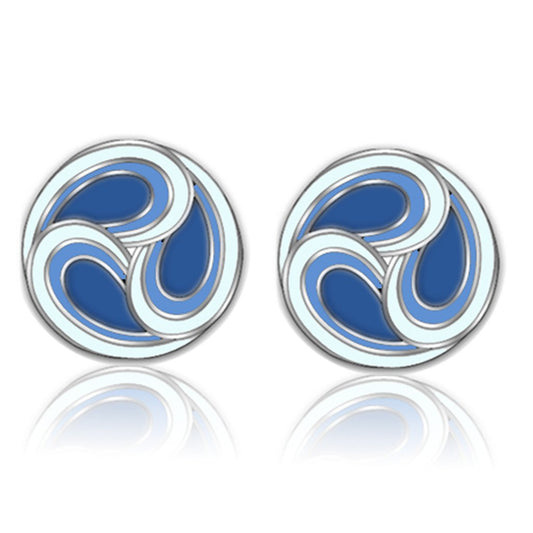With its romantic warmth and modern elegance, 14k rose gold has carved out a special place in the hearts of jewelry lovers. This stunning metal blends the timeless value of gold with a unique, blush-colored hue that flatters every skin tone, making it a favorite for everything from engagement rings to delicate everyday necklaces.
What Makes 14k Rose Gold So Special?
The magic of 14k rose gold isn't just its color—it's in its unique composition. Pure gold is a vibrant yellow, but it's far too soft for jewelry that's meant to be worn and loved for a lifetime. That's why rose gold is an alloy, a thoughtful mixture of metals engineered for both beauty and strength.
Think of it like a master chef’s recipe: pure gold provides the luxurious base, while other metals are added to create the perfect color, feel, and durability.
The specific formula for 14k rose gold is 58.5% pure gold, which is then blended primarily with copper and a small touch of silver. This balanced recipe is key to its appeal, giving it that characteristic pinkish hue and the strength to handle daily life.
The Science Behind the Blush Hue
The secret ingredient that gives rose gold its iconic pink tone is copper. The more copper added to the gold alloy, the deeper and redder the final color becomes.
For 14k rose gold, the blend strikes a perfect equilibrium. There's enough pure gold to maintain its precious value and classic luster, but just enough copper to create that warm, romantic glow while adding significant strength.
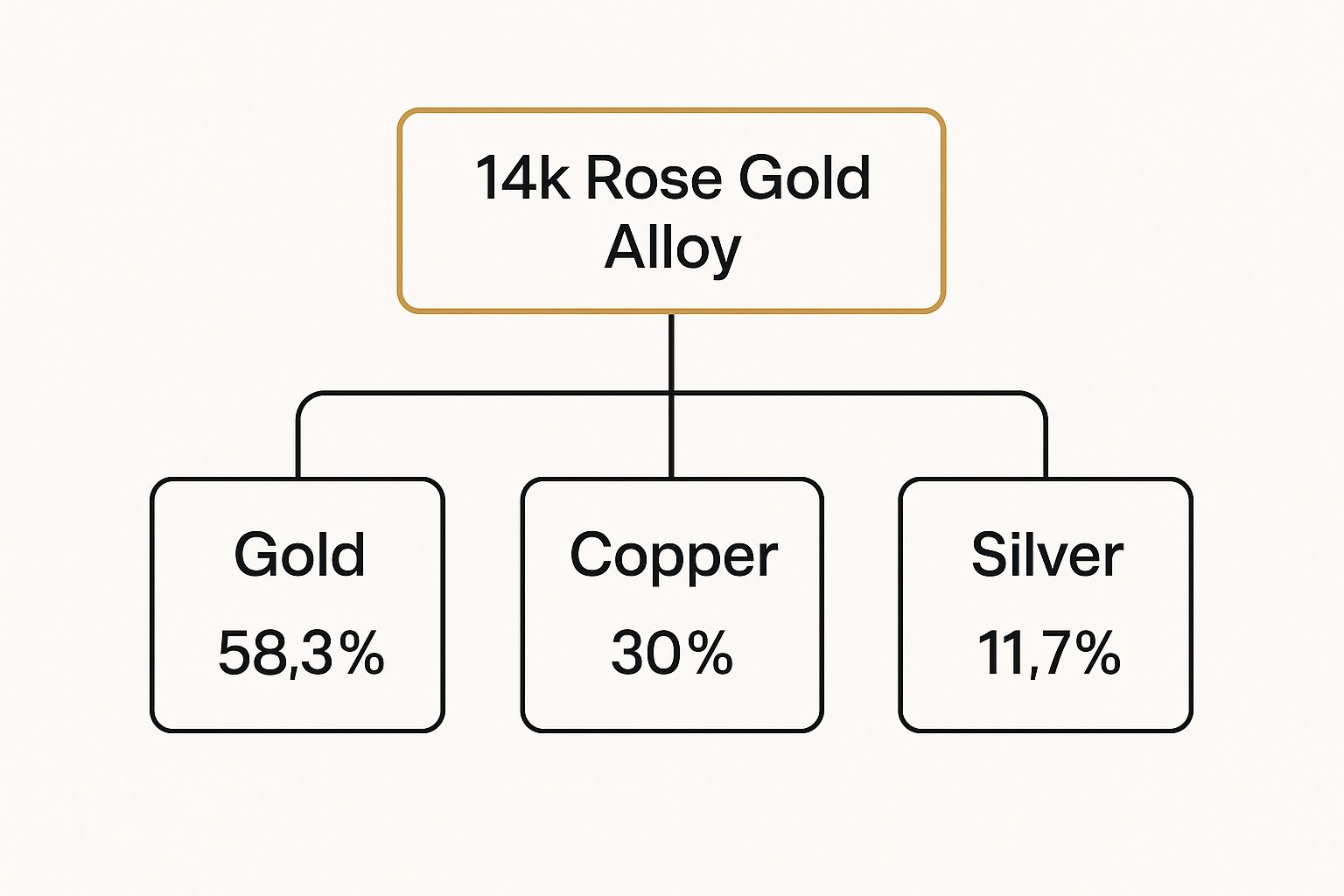
As you can see, nearly a third of the alloy is copper. This not only gives the metal its distinct color but also makes it much more durable than higher-karat golds.
To give you a clearer picture, here’s a quick comparison of how 14k rose gold stacks up against other popular choices.
14k Rose Gold at a Glance
| Feature | 14k Rose Gold | 14k Yellow Gold | Platinum |
|---|---|---|---|
| Color | Warm, pinkish blush | Classic, rich yellow | Bright, silvery-white |
| Durability | Very durable, resists scratches | Good durability, softer than rose gold | Extremely durable, very dense |
| Maintenance | Low; color is permanent | Low; color is permanent | Low; develops a natural patina |
| Hypoallergenic | Generally safe, but contains copper | Generally safe, contains various alloys | Excellent for sensitive skin |
| Price | Mid-range, affordable luxury | Similar to rose gold | Premium, most expensive option |
This table highlights why so many people are drawn to 14k rose gold—it offers a fantastic blend of beauty, strength, and value.
Why It Became a Modern Classic
The popularity of 14k rose gold has skyrocketed as fashion trends have shifted toward warmer, softer metallics. Its versatile shade pairs beautifully with both cool and warm tones, making it incredibly easy to mix with your existing silver, platinum, or yellow gold jewelry.
This adaptability has made it a go-to for designers and a staple in personal collections. If you're curious about gold alloys in general, you can learn more about what 14k means in our detailed guide on 14k gold. From delicate stacking rings to bold statement pieces, the charm of 14k rose gold is simply undeniable.
The Perfect Blend of Durability and Beauty
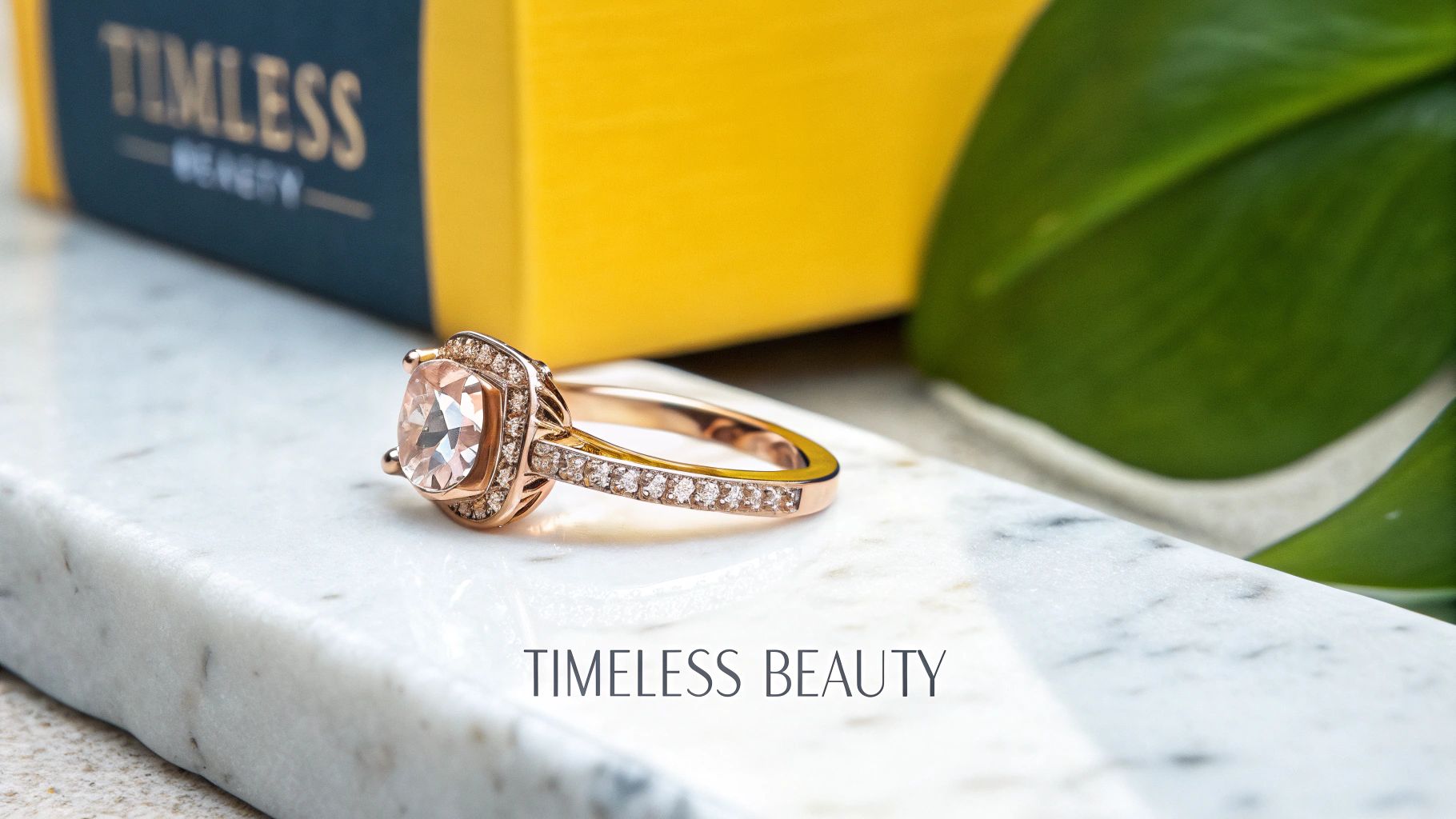
While the stunning blush color of 14k rose gold often gets all the attention, its hidden superpower is its remarkable resilience. The very same copper that gives it that signature warmth also transforms the metal, making it exceptionally strong and perfect for the demands of daily life.
Think of pure 24k gold as soft, malleable clay—beautiful in its raw form but far too delicate for practical use. By blending it with stronger metals like copper, 14k rose gold becomes more like fired ceramic: elegant, refined, and built to last. This transformation is what makes it such a practical and confident choice.
This added strength is crucial for jewelry you plan to wear often, like engagement rings, wedding bands, or your favorite everyday bracelet. The copper in the alloy hardens the gold, providing superior resistance to scratches and dents compared to softer, higher-karat golds like 18k or 22k.
Why Durability Matters for Your Jewelry
Choosing a durable metal means your investment isn't just beautiful—it's secure. A stronger setting provides better protection for precious gemstones, and the piece itself will hold its shape and finish for much, much longer.
The benefits of this robust alloy are clear:
- Scratch Resistance: The higher percentage of copper makes 14k rose gold harder and less prone to showing everyday scuffs and scratches.
- Structural Integrity: It holds its form exceptionally well, which is essential for intricate designs and for securely cradling diamonds and other gems.
- Longevity: This is a metal designed for a lifetime of wear, making it a reliable choice for pieces that carry deep sentimental value.
This practical durability is a huge reason why 14k gold alloys are consistently a top choice for everything from wedding bands to must-have pieces like our Diamond S-Link Tennis Bracelet, ensuring your most cherished items endure.
Key Takeaway: The copper in 14k rose gold is more than a coloring agent; it’s a strengthening one. It elevates pure gold from a soft, precious element into a durable, wearable alloy ready for everyday life.
A Smart Choice in a Growing Market
The appeal of gold jewelry is on the rise, driven by its dual role as both a beautiful accessory and a sound investment. Industry reports show a renewed consumer confidence in precious metals.
This growing market underscores the value of choosing a metal that is both aesthetically pleasing and structurally sound. With 14k rose gold, you get the best of both worlds—a fashionable piece with the inherent strength to be a lasting part of your collection for years to come.
Understanding the Nuances of Rose Gold Color
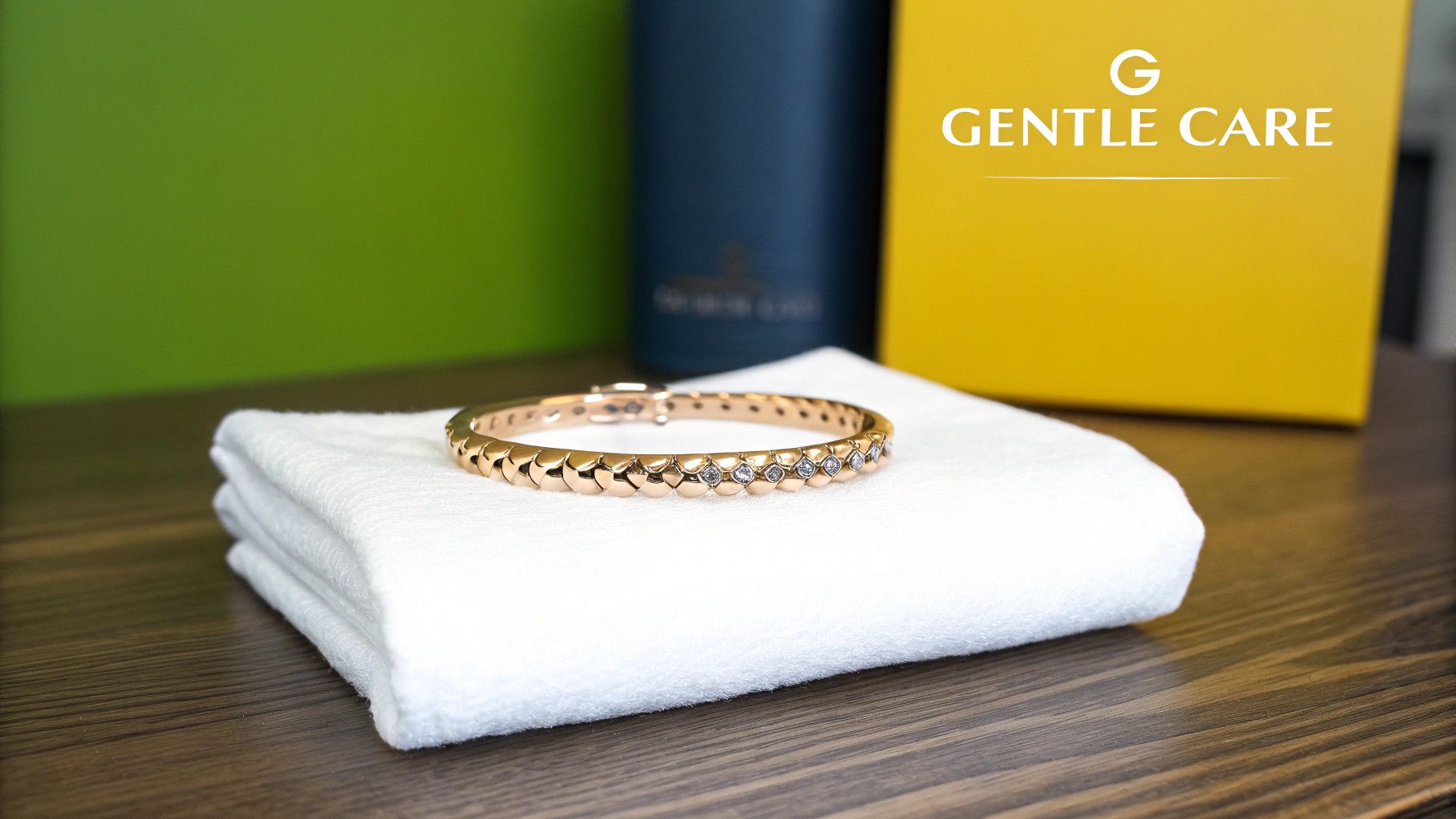
You’ve probably noticed that not all rose gold looks the same. One piece might have a soft, champagne-pink blush, while another boasts a deep, coppery red. This beautiful spectrum of color isn't an accident; it's a deliberate recipe crafted by jewelers.
Think of it like a painter mixing colors on a palette. The final shade of any rose gold piece comes down to the precise ratio of pure gold to its alloy metals, mainly copper. The more copper in the mix, the redder the final hue. This is where the magic—and the variation—happens.
How Karat Affects Color
The key to understanding that color difference is the karat system. A karat number tells you exactly how much pure gold is in the alloy, which in turn dictates how much room is left for copper.
Let’s break down the common variations you’ll see:
- 18k Rose Gold: Made of 75% pure gold, this alloy has less space for other metals. The lower copper content gives it a delicate, champagne-pink color with warm, golden undertones. It’s a subtle, almost ethereal shade.
- 14k Rose Gold: This is the sweet spot. With 58.5% pure gold, there's a higher concentration of copper than in 18k. This creates that classic, vibrant pink blush that has become so iconic—distinctly rosy without being overwhelmingly red.
- 10k Rose Gold: Containing just 41.7% pure gold, this alloy has the highest copper content of the three. As a result, it often has a much deeper, redder tone that’s noticeably bolder and more striking.
This knowledge is incredibly useful when you’re shopping. If you're looking for a gentle, understated piece to complement a fair complexion, the softer glow of 18k might be perfect. But if you want that rich, unmistakable blush, a stunning 14k rose gold piece like a Diamond S-Link Tennis Bracelet delivers that perfect, vibrant hue.
The rule of thumb is simple: more gold means a softer pink, while more copper means a deeper red. This makes 14k rose gold the ideal middle ground for that classic, balanced blush.
Tips for Matching Your Rose Gold Pieces
Because every jeweler has their own proprietary formula, you might notice slight color variations even between two different 14k rose gold pieces. Don't stress about finding a perfect match! Those subtle differences in tone can add depth and character to your jewelry collection.
When you're building a cohesive look, the easiest trick is to stick within the same karat family. A 14k ring will naturally harmonize with a 14k necklace, creating a polished and intentional style, even if their shades aren't identical.
How to Style Your 14k Rose Gold Jewelry
The real magic of owning 14k rose gold isn't just in its beauty, but in discovering how effortlessly its warm glow weaves into your personal style. Far from being a niche choice, that unique blush tone is incredibly versatile. It can elevate your go-to casual look just as easily as it complements formal attire.
So, let's explore how you can make this beautiful metal a signature part of your collection.
One of the best things about 14k rose gold is its knack for flattering a huge range of skin tones. The unique blend of soft pink and warm gold adds a subtle radiance that enhances just about any complexion.
While rose gold is often praised for its stunning contrast against fair and cool-toned skin, its coppery notes also bring out the warmth in olive and darker skin tones, making it a universally flattering choice.
This means you can wear your pieces with total confidence, knowing they’ll add a radiant, polished finish to your look.
The Art of Mixing Metals
Forget the old rule about sticking to just one metal. Mixing metals is a modern, stylish way to create a look that feels completely you, and 14k rose gold is the perfect "bridge" metal to tie everything together. Its warm undertones harmonize beautifully with both cool and warm metals.
For a chic, contemporary stack, try these combinations:
- With Yellow Gold: Pairing rose gold with classic yellow gold creates a warm, luxurious palette. The subtle difference in color adds depth and visual interest without ever clashing.
- With White Gold or Silver: When mixed with cooler metals like white gold, sterling silver, or platinum, rose gold provides a stunning pop of warmth. This contrast is both elegant and eye-catching.
A great way to start is by simply stacking a 14k rose gold ring next to your favorite silver or yellow gold bands. You’ll be surprised at how effortlessly they play off each other.
From Everyday Elegance to Special Occasions
The versatility of 14k rose gold extends to any event on your calendar. Its understated elegance makes it perfect for the daily grind, while its unique color ensures it stands out when it matters most.
For Daily Wear
For an everyday look, think delicate and timeless. A simple 14k rose gold pendant on a fine chain, a pair of classic stud earrings, or a sleek bangle adds a touch of sophistication without being overpowering. These are the kind of staples you can put on and forget about, pairing perfectly with anything from jeans to business casual.
For Statement Moments
When the occasion calls for something more, 14k rose gold delivers. Its romantic hue makes it an exceptional choice for bold, head-turning jewelry. Consider a piece like a stunning Diamond S-Link Tennis Bracelet in 14k rose gold to add instant glamour and a touch of romance to an evening gown or cocktail dress.
Its warm sparkle is distinct and memorable, ensuring you stand out in the best way possible.
Caring for Your Rose Gold Pieces
To keep your 14k rose gold jewelry looking as brilliant as the day you first wore it, a little mindful care goes a long way. The good news? Maintaining that signature warm luster is surprisingly simple and doesn't require any harsh chemicals or complicated routines. A gentle, consistent approach is all it takes.
The best way to clean your pieces at home is also the easiest. You just need a bowl of warm water and a few drops of a mild dish soap—that's it. This simple solution is perfect for lifting away the daily buildup of oils, lotions, and dust without harming the metal's beautiful finish.
A Simple At Home Cleaning Guide
For a quick and effective refresh, just follow these simple steps. This method is perfectly safe for most 14k rose gold jewelry, even pieces set with tough gemstones like diamonds.
- Prepare Your Solution: Fill a small bowl with warm water and mix in a few drops of a gentle, phosphate-free dish soap until you have a nice sudsy bath.
- Soak Your Jewelry: Let your rose gold pieces rest in the solution for about 15-20 minutes. This little soak does most of the work for you, loosening any stubborn grime.
- Gently Scrub: Grab a very soft-bristled toothbrush—a baby toothbrush is ideal—and gently scrub the jewelry. Pay extra attention to any nooks, crannies, or settings where dirt loves to hide.
- Rinse and Dry: Rinse the piece completely under clean, lukewarm running water. Then, pat it dry with a soft, lint-free cloth to prevent water spots and bring back that incredible shine.
What to Avoid and How to Store It
While 14k rose gold is definitely durable, some things can dull its sparkle. It's really important to keep your jewelry away from harsh chemicals like chlorine, bleach, and abrasive household cleaners. Always remember to take off your rings and bracelets before hopping in a pool or tackling cleaning chores.
Over time, you might notice the copper in your rose gold developing a slightly deeper, richer hue. This is a natural aging process called a patina, and many people love the vintage character it adds. But if you prefer the original bright finish, a professional jeweler can easily polish it back to its first-day glow.
Proper storage is just as crucial as cleaning. To prevent scratches and keep your pieces looking pristine, store them in soft-lined, elegant jewelry boxes. Keeping each piece in its own fabric pouch or a separate compartment is a great habit, as it stops them from rubbing against other jewelry. Understanding what causes jewelry to tarnish can also give you some extra insight into long-term care.
Why 14k Rose Gold Is a Smart Investment
Choosing a piece of jewelry isn't just about how it looks—it's about finding something with real meaning and staying power. And when you look at the whole picture, 14k rose gold isn't just a beautiful choice; it's an incredibly smart one. It hits that perfect sweet spot where timeless beauty, everyday strength, and lasting value all meet.
The secret is in its balance. With 58.5% pure gold, it has all the inherent worth and luxurious feel of a precious metal. But the addition of a strong copper alloy gives it the resilience needed for real life, protecting your piece from the bumps and scrapes that can easily damage softer, higher-karat golds.
A Blend of Timeless Style and Lasting Value
That warm, rosy glow of 14k rose gold is both incredibly fashionable and completely classic. It has this amazing ability to flatter literally every skin tone and looks stunning mixed with other metals, which means it’s a style that will never feel dated. In jewelry, that kind of aesthetic endurance is just as crucial as its physical strength.
But a beautiful piece of gold jewelry is more than an accessory; it’s a small piece of a huge global market. The worldwide gold jewelry market was valued at around USD 192.5 billion in 2024, and it’s only expected to keep growing. You can dive deeper into insights about the gold jewelry market and its projected growth, which confirms that you’re not buying into a fleeting trend but an asset with proven demand.
When you choose 14k rose gold, you’re getting the perfect trifecta: the enduring value of gold, the robust strength for daily wear, and a timeless look that you’ll love for years.
Ultimately, that combination makes the decision pretty clear. A stunning piece like a Diamond S-Link Tennis Bracelet in 14k rose gold isn't just something to wear—it's a smart, durable, and beautiful investment in your own personal style. It's a choice you can feel confident in, knowing you've picked a metal truly built to last a lifetime.
Common Questions About 14k Rose Gold
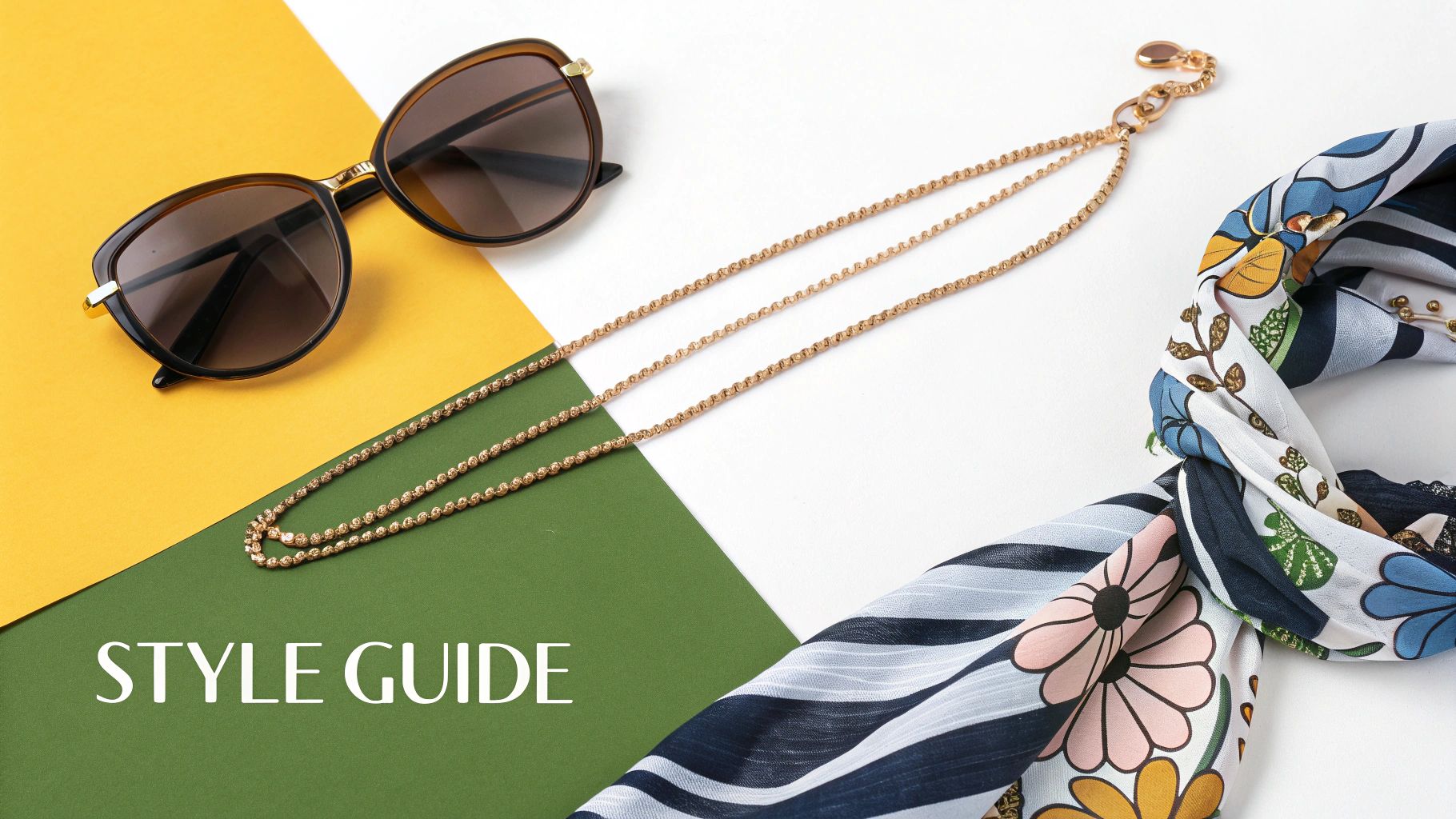
To make sure you feel completely confident in your choice, let’s clear up a few common questions about 14k rose gold. This quick guide should reinforce why this beautiful, durable metal is such a fantastic option.
Is 14k Rose Gold Hypoallergenic?
For most people, yes. However, since 14k rose gold gets its signature color from copper, anyone with a known copper allergy or extremely sensitive skin might notice a reaction. If you have very sensitive skin but love the look of rose gold, consider pieces that have minimal skin contact, like earrings or pendants, over rings which have constant contact.
If you have a history of metal allergies, it's always a good idea to test-wear a piece first or look for alloys specifically labeled nickel-free.
Does 14k Rose Gold Tarnish?
True tarnishing, like the green or black layer you see on silverware, isn't an issue with high-quality 14k rose gold. Because it is over 50% pure gold, it is resistant to corrosion. What can happen, though, is that the copper in the alloy may react with the environment and your skin over many years, developing a slightly deeper, warmer patina.
This natural oxidation is a very slow process that adds a vintage character many people find charming. But if you prefer that bright, fresh-from-the-box shine, a quick polish from a jeweler will restore it easily.
Is 14k Rose Gold Good for Engagement Rings?
Absolutely. It’s an excellent choice because it strikes the perfect balance between romantic beauty and everyday strength.
The 14k alloy is more than durable enough for daily wear and holds gemstones securely, making it a much more resilient choice than softer 18k or 24k gold. Plus, its warm, romantic hue is a modern and distinctive alternative to traditional yellow or white metals. This durability means your ring will withstand the rigors of daily life while securely protecting the center stone.
Ready to add the timeless warmth of 14k rose gold to your collection? Explore the stunning and affordable designs at Precious Pulse Jewelry and find your perfect piece today.

